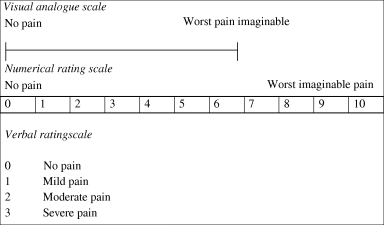Abstract
The purpose of this study is to examine the literature on the Visual Analogue Scale, Verbal Rating Scale, and Numerical Rating Scale—three widely used pain rating scales. The evaluation offers the details required to comprehend the scales' primary characteristics. It is easy to misinterpret data produced by pain-rating scales. Clinicians can make appropriate use of these tools by understanding their key aspects with the aid of this review. A Medline review using PubMed was conducted without regard to the age of the papers that were retrieved. Before being included, papers were reviewed for methodological soundness. The original search terms were Visual Analogue Scale (VAS), Verbal Rating Scale (VRS), Numerical/numeric Rating Scale (NRS), pain rating scales, pain measurement, and VAS. Additional papers and search phrases were produced using the reference lists of the articles that were obtained. Only papers written in English were looked at. Although the Visual Analogue Scale presents more practical challenges than either the Verbal Rating Scale or the Numerical Rating Scale, all three pain-rating measures are valid, dependable, and suitable for use in clinical practice. The Numerical Rating Scale produces data that can be statistically analysed for auditing purposes and has good sensitivity for general uses. It is likely that patients who are looking for a sensitive pain rating scale would select this one. Patients like the Verbal Rating Scale for ease of use, however it is insensitive and the results it generates may be misinterpreted
Keywords
Pain measurement, Pain assessment, Numerical Rating Scale, Verbal Rating Scale, Visual Analogue Scale, Pain Rating Scale
Introduction
The Royal College of Surgeons and Royal College of Anaesthetists (1990) managed routinely, and that both pharmacological and non-pharmacological interventions should be considered. These guidelines also emphasize the importance of individualized care, taking into account patient preferences, pain levels, and the underlying causes of the pain. Further more, the integration of multidisciplinary teams, including nurses, physiotherapists, and psychologists, has become essential in providing comprehensive pain management. The shift toward establishing acute pain services within the NHS reflects a growing recognition of the need for effective pain control in patients, particularly after surgery or trauma. These services have become a cornerstone in improving patient outcomes, reducing complications, and enhancing overall patient satisfaction. on their effectiveness and suitability in different clinical settings. By evaluating the characteristics of these scales, the review seeks to highlight the strengths and limitations of each, as well as to provide insights into how they can best be utilized to assess pain in a consistent and reliable manner.7
APPROACH:
PubMed was used to conduct a Medline search. As the procedure progressed, the search method changed. Among the first search terms were verbal rating scales, numerical rating scales, visual analogue scales, pain assessment instruments, pain measurement, and pain rating scales. A new batch of research articles and additional search terms were produced by looking through the reference lists of the gathered research articles. There was no time limit on the search. Papers in English were the only ones recovered. Every article was evaluated for methodological soundness and data reliability.3
FINDINGS:
The Complexity of Pain:
Intensity is not the only factor important in the experience of pain; pain occurs within a context. The patient's interpretation of the pain and its anticipated length have an impact on how severe the pain is (Turk & Melzack 1992). Along with expectations, attitudes, and beliefs, the environment also affects how pain is experienced. Although psychological variables rarely cause pain, it is linked to emotional and psychological repercussions like depression, worry, and dread. Different degrees of dysfunction, impairment, or altered behaviour can result from either acute or chronic pain. Several research has shown that pathology and pain do not correspond well; moreover, pain does not necessarily disappear when there is no discernible pathology (Wiesel et al. 1984, Boden et al. 1990, Turk & Melzack 1992).8
Properties of the Visual Analogue Scale:
Verbal descriptions, often "no pain" and "worst imaginable pain," serve as the anchors for the 10-cm line that represents the VAS (Fig. 1). To determine the level of pain, the patient is asked to draw a line at 100 mm. The patient's mark and the zero anchor are used to calculate the score. 101 levels of pain intensity can be obtained by measuring the patient's score on a millimeter scale. The requirement to administer the VAS electronically or on paper is one of its drawbacks (Kremer et al. 1981, Dixon 1986, Jensen et al. 1986, Guyatt et al. 1987). The scale's length may alter significantly if it is photocopied, so caution is advised (Jensen et al. 1986, Snow & Kirwan 1988). The statistical distribution of the data acquired with the VAS may vary depending on its graphic orientation. Data were regularly distributed when the VAS was utilized horizontally, but not when it was used vertically, according to Ogon et al. (1996). Although there is good correlation between data from horizontal and vertical VAS (Scott & Huskisson 1979a, Hinchcliffe et al. 1985), there is little agreement between the two (Dixon 1986). The vertical scale showed less inaccuracy than the horizontal scale in a study of Chinese patients (Aun et al. 1986). When the VAS was presented vertically, a similar study (Scott & Huskisson 1979b) examining its application by English language speakers discovered that the failure rate was 7%, although presented horizontally. This implies that the VAS's graphic orientation ought to be chosen based on the typical reading habits of the population it is intended for1.

The Numerical Rating Scale:
The endpoints of the 11, 21or 101 point NRS scale are the absence of pain, the severe pain, and the greatest pain possible. The NRS can be presented orally or graphically. Depending on how many levels of discrimination are supplied to the patient, the scale is called an 11- or 21-point box scale. When the numbers are displayed graphically, they are frequently encased in boxes. The distribution and inaccuracy of the data acquired with the NRS are not documented. The scale is interval level, nevertheless, and can supply information for parametric analysis.4
The Verbal Rating Scale:
A collection of descriptors that indicate escalating pain intensities makes up the VRS. No discomfort, mild pain, moderate pain, and severe or excruciating pain are the most often used terms. These adjectives are given numbers to make recording them easier. These ranks numbers may cause errors because they give the false impression that the gaps between each descriptor are equal (Jensen & Karoly 1992). The VRS is ordinal. Regarding the dissemination of data gathered from the VRS, there is no documented information. Non-parametric statistics are typically the only way to analyse data that was gathered via a VRS.2
How do changes in pain intensity scores relate to percentage changes in pain? It is common to use percentage reduction in pain as a means to compare treatments or monitor progress. To work out the percentage pain reduction the following calculation is used:5
(Difference between pre and post pain scores)
100x =
Pretreatment intensity
What constitutes a change in pain intensity that has clinical significance?
In addition to other routine measurements that monitor the patient's progress, health care providers are encouraged to regularly record the patient's pain, which is frequently referred to as the fifth vital sign. 50% pain reduction has been referenced in scientific publications as a statistically significant reduction (Rowbotham 2001). Using the Global Rating Scale, Farrar et al. (2001) determined that a clinically significant change in pain was "much improved" or "very much improved," which corresponded to a 30?crease in pain. In a previous study, Farrar et al. (2000) used data from a transmucosal fentanyl trial for cancer pain and compared a 33% pain reduction with mild improved pain management for 130 individuals. Interestingly, repeated VAS assessments can have a 20% variability, even though a 33% reduction might be important for the patient (Rosier et al. 2002).6
To what extent is pain moderate or severe?
In clinical practice, the VRS is frequently utilized. Despite the temptation to use a linear scale to measure the patient's discomfort, the VRS uses rank scores for convenience of recording. To measure the frequently used adjectives, three research have looked at the VRS (Serlin et al. 1995, Collins et al. 1997, Briggs & Closs 1999). According to research by Serlin et al. (1995), cancer patients reported that mild pain ranged from 1 to 4 on an 11-point scale, moderate pain ranged from 5 to 6, and severe pain was denoted by a score of seven or above. Collins et al. (1997) used a different method with patients experiencing acute pain and discovered that moderate pain was represented by a score of about 30 mm on a 100 mm VAS, while severe pain was represented by a score of 54 mm or higher. Cancer patients defined severe pain as measuring 35 mm or more on the VAS, according to Briggs and Closs (1999).10
Patients must have access to their past scores:
The patient is unlikely to be able to correctly position their present score without access to the "score history" (Scott & Huskisson 1979a, Farrar et al. 2000). There is a claim that asking patients to score without consulting their prior scores is more accurate if the goal is to get their opinion of their absolute pain score at a certain moment in time (Jacobsen 1965). Scott and Huskisson (1979b) point out an issue: data generated from a patient's score without progression. It is appropriate to reduce error by displaying the patient's prior score, as repeated measures using the VAS result in errors of about 20 mm (DeLoach et al., 1998) or 20% (Rosier et al., 2002). According to Joyce et al. (1975), patients had a 3:1 preference for viewing their prior score or not. It's unknown why this decision was made.11
Preferences of patients:
While some patients prefer the simplicity of the VRS or the NRS, others prefer the sensitivity of the VAS (Joyce et al. 1975, Van Tubergen et al. 2002). A categorical scale like the VRS is easier for older adults and children with lower abstract capacity to utilize (Kremer et al. 1981, Fanurik et al. 1998, Radbruch et al. 2000). Nevertheless, there is no proof that these organizations are unable to utilize the NRS.9
CONCLUSION:
The Pain Scales plays a key role in the assessment of Pain.
REFERENCES
- Aun C, Lam YM & Collett B (1986) Evaluation of the use of visual analogue scale in Chinese patients. Pain 25, 215–221.
- Briggs M & Closs JS (1999) A descriptive study of the use of visual analogue scales and verbal rating scales for the assessment of postoperative pain in orthopaedic patients. Journal of Pain and Symptom Management 18, 438–446.
- Bijur PE, Latimer CT & Gallagher EJ (2003) Validation of a verbally administered numerical rating scale of acute pain for use in the emergency department. Academic Emergency Medicine 10, 390– 392.
- DeLoach LJ, Higgins MS, Caplan AB & Stiff JL (1998) The visual analogue scale in the immediate postoperative period: intrasubject variability and correlation with a numeric scale. Anaesthesia and Analgesia 86, 102–106.
- Jamison RN, Gracely RH, Raymond SA, Levine JG, Marino B, Herrmann TJ, Daly M, Fram D & Katz NP (2002) Comparative study of electronic vs. paper VAS ratings: a randomized, crossover trial using healthy volunteers. Pain 99, 341–347.
- Jensen MP, Turner JA & Romano JM (1994) What is the maximum number of levels needed in pain intensity measurement? Pain 58, 387–392.
- Royal College of Surgeons & Royal College of Anaesthetists (1990) Commission on the Provision of Surgical Services: Report of the Working Party on Pain After Surgery. Royal College of Surgeons and Royal College of Anaesthetists, London.
- Turk DC & Melzack R (1992) The measurement and assessment of people in pain. In Handbook of Pain Assessment (Turk DC & Melzack R eds). The Guildford Press, New York, pp. 3–12.
- Kremer E, Atkinson JH & Ignelzi RJ (1981) Measurement of pain: patient preference does not confound pain measurement. Pain 10, 241–248.
- Farrar JT, Young JP Jr, La Moreaux L, Werth JL & Poole RM (2001) Clinical importance of changes in chronic pain intensity measured on an 11-point numerical pain rating scale. Pain 94, 149–158
- Littman GS, Walker BR & Schneider BE (1985) Reassessment of verbal and visual analogue ratings in analgesic studies. Clinical and Pharmacological Therapy 38, 16–23.


 Paruchuri Mounika*
Paruchuri Mounika*
 Veergandam Satyanarayana
Veergandam Satyanarayana
 Shaik Mabu Subhani
Shaik Mabu Subhani
 Chevula Nikhila
Chevula Nikhila
 Gangisetty Sampath
Gangisetty Sampath
 Manchala Vamsi Vardhan
Manchala Vamsi Vardhan

 10.5281/zenodo.14810676
10.5281/zenodo.14810676